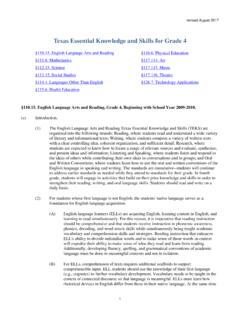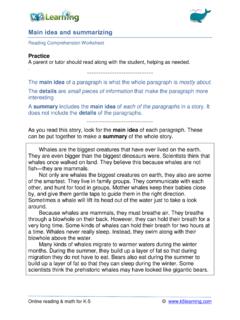Transcription of Target Reading Rates by Grade Level - Kent State University
1 Directions for Administering the Graded Passages The versions (A D for grades 9 12 A and B for adult literacy students at grades 1 8) of Graded Passages are about different topics but similar in length and readability. This will enable you to test students at different points throughout the school year. Each passage is labeled with Grade Level as well ( , 9A is the ninth Grade passage in Set A). Two copies of each passage are provided, one for the student to read and another (marked with word counts, scoring blanks, and readability information) for you to use. Administering the Graded Passages is simple and straightforward.
2 You simply ask students to read a Grade Level passage to you and ask them to recall what they remember from the passage after it has been read. While students read and recall the passage, you monitor their performance for word recognition, fluency, and comprehension. The specific directions are outlined below. 1. Present the student with a copy of the passage from Graded Passages that corresponds to his or her assigned Grade Level . Adult literacy teachers may want to use the Grade Level that best corresponds with the student s TABE score.(We ask students to read at their assigned Grade levels in order to determine their Level ofperformance on passages that they are expected to master during that Grade Level .)
3 Ask the student to read the passage orally to you in a normal manner. Tell the student that at the end of the Reading you will ask himor her to recall what was read. 2. Have the student read the passage aloud for 60 seconds. If the student stops at an unknown word and does not attempt to pronounce it for 2 seconds, or if the student attempts the word but clearly has little chance of Reading it correctly, tell the student the word and ask himor her to continue Reading . During the oral Reading you should have a copy of the passage in front of you. Mark any uncorrected errors that the student makes by drawing a line through the missed word.
4 Errors include words that are mispronounced or omitted or that you provide to the student. If a student mispronounces or omits a word, but later corrects it, write and circle a c above the word to indicate it was corrected. At the end of the 60 second period, mark where the student is inthe text. 3. After the student has read for 60 seconds, direct his or her attention to the beginning of the text and ask the student to follow along silently while you read the text aloud. Read in a normal and expressive voice. (You read the text to the student to remove anyword recognition or fluency difficulties that may hamper the student s comprehension of the passage.)
5 Listening comprehension is a good measure of Reading comprehension). At the end of your Reading , remove the passage from view and ask the student to tell you what he or she remembers from the passage. After the student has retold the passage, ask if he or she remembers anything else. Especially if the student has made few oral Reading errors, you may, as an alternative to Reading the passage to the student, ask himor herto read the rest of the passage silently. At the end of the student s Reading remove the passage from view and ask for the retelling. Keep in mind that a source of difficulty in comprehension may be problems in word recognition or fluency.
6 After the student has retold the passage, the assessment is complete and needs to be and Interpreting the Graded Passages Scoring the Graded Passages is simple and quick. The following procedures should be followed: Word Recognition (Decoding). Word recognition is determined by calculating the percentage of words read correctly in the 60 second oral Reading . Divide the totalnumber of words read correctly by the total number of words read (correct and incorrect). For example, if the student read a total of 94 words in 60 seconds and made 8 errors, the percentage of words read correctly would be reflected in the following fraction: 86 / 94 (86 divided by 94) = In other words, the student read of the words correctly.
7 Instructional Reading Level is normally marked by a word recognition accuracyrate of 92 98%. Independent Reading Level is normally marked by an accuracy rate of 99 100%.Word recognition scores at or below 91% indicate that the student will find material at this Level much too difficult to read. A normally developing student might begin the school year with an instructional Reading levelat a certaingrade and end the year with an independent Reading levelat the same Grade . For example, a ninth grader s performance on a ninth Grade passage might be instructional at the beginning of the year but independent by the end of the year.
8 Students who perform at the frustration levelon this assessment or who do not demonstrate goodprogress over the year should be considered for additional assessment to confirm their decoding difficulty. Such students may benefit from specific instructional intervention in decoding. Reading Fluency Automaticity. One way Reading fluency can be measured is through Reading rate. Reading rate provides a measure of the extent to which a reader can automatically decode words, thus leaving cognitive resources free for the more important task of comprehending a passage. To determine rate, simply count the number of words the student has read correctly during the 60 second oral read.
9 (Words read correctly include those words that the student initiallymisreads but then later corrects.) Then compare the students performance against the Reading Rates shown below for the appropriate Grade and time within the Reading Rates by Grade Level Grade Fall Winter Spring 1 0 10 wcpm 10 50 30 90 2 20 80 40 100 60 130 3 60 110 70 120 80 140 4 70 120 80 130 90 140 5 80 130 90 140 100 150 6 90 140 100 150 110 160 7 100 150 110 160 120 170 8 110 160 120 170 130 180 9 10 120 170 130 180 140 190 11 12 130 180 140 190 150 200 Students whose Reading rate falls within the appropriate range shown above are performing at Grade Level expectations.
10 Students who fall below the range may be considered at risk in terms of fluency automaticity. Students whose Reading rate is above the range may be considered to be doing well in fluency auomaticity however, students who read exceptionally fast without attending to punctuation and other phrase boundaries, who read without sufficient expression, or who read quickly at the expense of comprehension may also be considered at risk in fluency. Additional assessment may be appropriate for students who perform poorlyon this assessment or who do not show improvement over the course of the school year. Students considered at risk in fluency may benefit from instruction aimed at improving Reading fluency.





